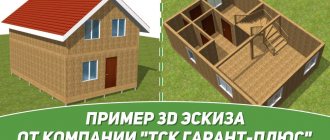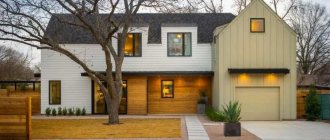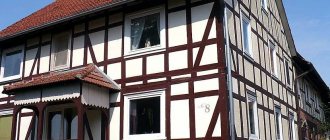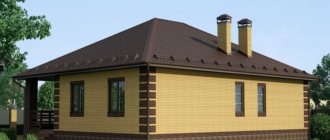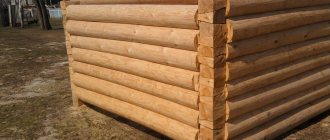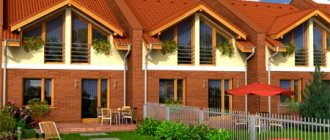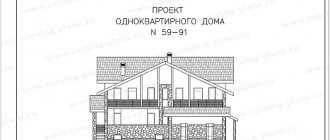In our catalog, house designs in the Russian estate style take pride of place. This is explained by the growing interest in log house construction, and logically leads to the revival of half-forgotten elements of ancient Russian architecture. Our ancestors knew how to create fabulous masterpieces from wood.
Despite the absolute external dissimilarity of each house in the catalog, they can still be divided into two large groups. One includes projects of classic Russian manor houses, the second includes ethnic stylizations such as “fairy-tale mansions”.
Russian style estate project
| House with a multi-tiered roof | House with wooden carvings | Cottage made of combined materials |
This concept usually includes a traditional, often one-story, residential building, or rather, a complex of wooden buildings along with a bathhouse, an outbuilding, a fence and a gate, forming an entire “yard.” Modern projects use several techniques of traditional Russian architecture.
- Log houses can be assembled from logs of different diameters, laid “butt to top”.
- Multi-tiered roofs of various shapes - “chest”, acute-angled, 4-pitch.
- The gables are made from the same logs as the walls - there is a feeling that they stand “by themselves”, without any support (“males”).
- Characteristic are peculiar “bay windows” - half of a hexagonal “drum” protruding beyond the wall.
- Wooden carvings are the hallmark of the house. The porch, platbands, and overhanging edges of the roof are richly decorated with figured elements.
- Open galleries “gulbishcha”, small cozy balconies are supported on carved wooden columns.
A characteristic feature of Russian houses is individuality. Each of them is unique, expressing the taste and wealth of the owners of the house. In a modern interpretation, a cottage can be built from brick in the Russian style, or with combined stone walls. The combination of materials of different textures gives the building a new look, while maintaining all the charm of a wooden frame.
How to establish your own family estate?
There are several key points in your question, let's look at them in order.
The first point: “why use the term “investment”, because there is no investment attractiveness. There was no increase." If we now reduce everything to bare mathematics, then the investment attractiveness of both an apartment and an ounce of gold is nonexistent. Some things cannot be repaid in principle in a human lifetime, some are eaten up by inflation. The truth is that there are tools for preserving finances in the long term and they are influenced by many more economic factors.
Then you say: “it’s hard to sell something that no one wants.” This is emotional rhetoric, the legs of which grow from the past: in Russia there is a lot of land, collective farms have collapsed, no one needs the land. Tell a German or a Dutchman that you can buy a hectare from us - he will widen his eyes, because for him it is of great value. You cannot look at the issue of land from a 1-2 year perspective; this is a strategic issue. But strategically, the truth is that land is no longer being produced, and the territories of each state are finite. Therefore, in different places at different speeds, but the value of land has grown and will continue to grow, and so will its value.
I would like to mention the villages of the Tver region, which look like after a disaster. Here, alas, we understand that criticism is deeply embedded in the Russian mentality, but objectivity is not always there. Why, when they go to villages that have died for various reasons, no one goes to successful farms.
For example, a farmer from the Konakovo region, Maxim Selivanov, makes jamon and basturma. Alexey Trofimov, a young farmer from the Bologovsky district of the Tver region, chairman of the Russian Union of Rural Youth of the Tver region. He has been engaged in agriculture since 2012 and has won several grants. He is involved in cattle and dairy and meat production. Recently he won the “Business Environment” competition, and we also donated a hectare to him. And, by the way, he didn’t say that he didn’t need the land. He has plans to expand! The list goes on. And I would like the media to cover problems objectively, bringing to light not only problems, but also achievements.
And about the low rate of land development. Yes, unfortunately it is. We are accustomed to this in the age of high speeds: we came up with it in 2 weeks, produced it in 2 weeks, and a year later the business died. The earth lives by different laws, and even if you build a house in 3 months, you will not grow a cucumber in 3 days instead of allotted to it. We have an example where a person who previously lived in Kuban moved to Moscow, bought a plot of land, and built a house within a season. The important point is that he knew how.
There is one factor here that everyone forgets; we have basically lost knowledge of what should be done with the land in general. Not every man here is a carpenter, and not every woman is a summer resident. An informationally modern family, even when it knows what it wants, has little idea how. In this regard, we set ourselves the task of creating the most detailed knowledge base. We send our farmers to study at the Synergy University Business Farm, where they are taught how to organize peasant farms and make them profitable. We are preparing to launch our own school for those who would like to master the area faster, but lack knowledge.
Traditional house in Russian Terem style
| Russian chalet project | Log house in Oglo |
The first wave of interest in medieval Russian architecture arose in the 19th century, and the “pseudo-Russian style” arose on its crest. Of the house designs of Russian architects of that period, the works of Ivan Ropet, who built many “mansions” with multi-tiered turrets and carved patterns, have survived. Among the techniques of the 18th century, two stand out that can give a wooden house a particularly “fairy-tale look.”
- Russian chalet is a building with a log house that expands upward due to a gradual increase in the output of crowns (“fall”). They formed a cornice on which the roof was laid, the overhangs of which could be significantly increased. Nowadays this is a rare technique; modern houses of this type are rather a stylization on the theme of a chalet.
- A log house “in the oglo” is a connection of logs in the corners of a log house with the remainder (remember the house of “Baba Yaga”). The project of a tower in the Old Russian style in our catalog includes such rare elements: figured columns with carvings, a hexagonal glazed “lantern”.
All house designs developed by us in the Russian estate style are accompanied by a full package of architectural and constructive solutions. The attached specification of materials facilitates the work of builders and ensures that the building being constructed complies with the technical plan.
Projects of pre-revolutionary houses
- Project of a pre-revolutionary country house No. 1. Vl. Story
Square: 65 m2
- Pre-revolutionary project of a rural house 1880
Square: 115 m2
- Pre-revolutionary project of house No. 47. G. Sudeikin
Square: 130 m2
- Project of a pre-revolutionary two-story house No. 52
Square: 200 m2
- Project of an ancient house No. 12. Architect G. Sudeikin
Square: 155 m2
- Project of a two-story dacha No. 51. Architect G. Sudeikin
Square: 150 m2
- Project of an ancient house "Retro-1"
Square: 290 m2
- Project of an ancient house "Retro-2"
Square: 320 m2
- Project of an ancient house "Retro-3"
Square: 235 m2
- Ancient bathhouse project “Retro-4”
Square: 120 m2
- Project of a two-story country house No. 2
Square: 85 m2
- Ancient project of house No. 101. Architect G. Sudeikin
Square: 130 m2
- Ancient project of house No. 102. Architect G. Sudeikin
Square: 130 m2
- Fairytale tower based on V.M. Vasnetsova
Square: 350 m2
- Ancient northern house “Alyoshkin House”
Square: 140 m2
- Project of an ancient Ural peasant hut
Square: 85 m2
The source documentation for the restored architectural projects of ancient houses is “Cheap Buildings” by the architect Storey, 1914, “Project Albums” by the architect Sudekin, 1915 and measurements of the ruins by the carpenters of our company
The timing and cost of design and construction of the bathhouse are explicitly specified in the contract
Where can I get it?
A plot for a family estate can be obtained in any part of the country, since the state has designated vast territories for the creation of such. The only condition here is the corresponding category of intended purpose of the land where the plot of interest is located.
A list of territories allocated for the creation of an estate with the construction of a house and other buildings is available in each regional cadastre office under the local administration. The list is compiled by authorized persons in regional centers, and then approved and certified by the federal cadastre body.
It is important to clarify that the interested person cannot independently select a plot to create an estate, since the list of potential plots for these purposes was previously determined and approved by the municipality and federal authorities. The only option may be to select from already approved areas recorded as territories for family estates.
Differences between our houses
The design of estates is carried out by qualified specialists, so even the smallest details are thought out in the project - from the design style to a convenient layout. We work with high quality finishing materials, which ensures reliable assembly. We provide a guarantee for construction and finishing, we work quickly and in a short time.
Our estates are also distinguished by modern engineering systems and excellent design - we offer installation of Smart Home systems, and carry out all turnkey work from design to construction and landscaping.
Agricultural technology. High ridges
The first thing that needs to be done during the planting season is to build windbreaks and high ridges, for which the Austrian farmer Sepp Holzer became so famous. He is in the Alps, at an altitude of 1.5 km above sea level (in “Austrian Siberia”), and manages to grow peaches. High ridges 1.5 m high and higher create a special microclimate. Firstly, they shelter the plants from the wind. From my own experience, as soon as I transplanted my father’s apple trees from a bare spot under the fence, they stopped freezing and began to bear fruit. Secondly, the sun's rays fall perpendicularly on the surface of the ridges, which lengthens both the spring and autumn growing seasons by half a month. And thirdly, moisture is always retained between the ridges, which eliminates the need to water the plants. In general, the ideal of the Family Estate is to do it once, but for centuries, so as not to cause trouble for grandchildren and great-grandchildren. Sepp Holzer does not water his beds at all. Drawing from the book “Sepp Holzer – Revolutionary Agrarian”. High ridges are filled inside with dead wood, grass and other organic matter, the process of decay of which releases heat and nutrients that favor the development of plants. In addition, when there is excess moisture, the wood swells and “moves” the bed, and through the cracks that appear, the air needed by the roots gets into the soil. In my clay soil this is doubly important. I plan to take dead wood from the neighboring forest, at the same time bringing it into a standard state; my “four” can be loaded with a lot. Sepp Holzer makes his high beds with an excavator; due to lack of funds, I will have to do it manually. For this I have two sons and six months of vacation. During this time you can move mountains. In addition, three trainees have already signed up and want to learn the new agricultural technology. High ridges along the pond will also be formed from the soil left over from digging the pit, this will make the work easier. I plan to build a vegetable storage area inside one of the shafts, since it cannot be buried in the ground due to high groundwater. Perhaps it is worth setting up a bathhouse in the shaft - it is close to the pond, and the thermal insulation is ideal. And here we come to the question of cooperation. Returning from the editorial office, I constantly see how trees are “standardized” and branches are taken away by KAMAZ trucks. Delivering them, as expected, to a solid waste landfill costs money. I'm willing to take all wood (even old houses) for free. And I need a lot of it, besides, I have friends and neighbors - there are 36 plots in our emerging settlement. And in addition to personal high ridges, we will build a public Harvest Land, the products of which will be fed to our guests, participants of festivals and seminars, as well as visitors from the city, who will be able to both relax here and purchase fresh products. Of course, you have to travel further to us than to Samosyrovo; we are located 30 km from Kazan, but for those who are interested, here is the contact number 8-917-878-05-91. After all, branches are cut not only in Kazan, but also along roads. (Figure from the book “Permaculture by Sepp Holzer”) I am also ready to take stone, especially border stone (stone helps heat the water in the pond, retains moisture and heat on land), fittings, pipes. The bricks will be used to fill the road through the ravine, and if during the overhaul there is nowhere to put the doors and window frames, then we will make wonderful greenhouses and floors for the common house. And in addition to the economic effect, you will have information where you can buy real organic products in the fall.
The procedure for obtaining an allotment for a family estate
To obtain land, you will need to contact the administrative authorities of the region where you would like to live and write an application in the established form. After consent from the authorities, the plot is awarded to a specific family or citizen free of charge and with the right to lifelong use.
If 3 or more families are interested in creating an estate, each of them must submit an application. In this case, the territory is assigned the status of a village, and the municipality undertakes the obligation to lay utility networks in the specified area.
One way or another, to legalize ownership of the plot, you will need to take the following actions:
- Selection of a site from the list of territories approved for the creation of family estates. Obtaining an extract from the Unified State Register of Real Estate about the absence of an owner of the area and confirmation that it is in the possession of the state.
- Clarification of information through a visit to the land committee regarding the presence of encumbrances on the selected site, for example, arrests, prohibitions. If there are no restrictions, you should obtain a document confirming this fact.
- Submitting an application for the provision of land for a family estate to local authorities.
Along with the application form, you will need to provide a plan for the development of the site, as well as a document on land surveying and registration of its boundaries. Additionally, a permit from the cadastre for the use of land must be attached.
It is worth clarifying here that there is no clearly regulated procedure for obtaining an allotment for an estate. In any case, you will need to contact the cadastre authorities to obtain an approved list of territories, and then visit the administration to clarify the progress of the procedure and submit an application.
To the very outskirts
Family estates cease to be the initiative of individuals. In the Altai Territory, the regional target program “Rural Revival through the creation of settlements from Family Estates” is being adopted. On February 18, 2010, the Belgorod Regional Duma, at the suggestion of Governor Evgeny Savchenko, adopted the law “On Family Estates in the Belgorod Region.” According to the adopted Law, land of at least 1 hectare in size is issued free of charge, without the right to sell, with the right of inheritance. Also, in the settlements where family estates will be built, the state, at its own expense, plans to build roads, electricity, and in the future it is planned to build schools. Despite some resistance in promoting the Law, Yevgeny Savchenko said at one of the meetings with his opponents: “But there will still be localization of Russia!” I would like to express my personal gratitude to Governor Yevgeny Savchenko for his wisdom and insight, for creating a legislative precedent. Now the very concept of “family estate” has appeared in the legal field of Russia. And the localization of Russia is already underway and gaining momentum. In 2010, 422 families wintered in 71 settlements in Russia, of which 321 families in 49 settlements in the European part and 101 families in 22 settlements in the Urals and Siberia. In Ukraine, 74 families wintered in 15 settlements, in Belarus, Moldova, Latvia, and Kazakhstan - 16 families in 4 settlements. In total - 512 families in 90 settlements. In the fall of 2011, my family will be among these families (maybe 1.5 thousand, maybe 15 thousand). And for this I (without any irony) thank the financial crisis and the increase in housing and communal services tariffs. My wife, who just 2 years ago had a cool attitude towards the estate and asked a lot of unnecessary questions like “Won’t it be boring in winter?” and “How to make money?”, now with each receipt for payment of utility services I become more and more convinced: “That’s it! It's time to land!" And my daughter, having watched another program about the use of preservatives in the food industry (she was especially struck by the fact that in Europe the dead do not decompose in the ground for decades, i.e. people are mummified alive by preservatives) found out that from the entire typical selection of supermarkets you can only eat buckwheat , and sat down to draw a plan of the Family Estate. Understanding full well that our entire people are in a similar situation, and soon people will be (already are) reaching out to the ground, I want to share my experience (the son of difficult mistakes) of arrangement. And, first of all, to convince that this does not require a lot of money. Money is needed to fight nature, and to cooperate with it, simply understanding the processes taking place is often enough. I will also announce plans for the season, especially since there are specific opportunities for cooperation with construction, road and housing organizations.
In the price of a log house we included:
- House design at the AR stage
- Scheme of cutting down a log house at the RF stage
- Making a log house at the production site:
- The logs of the log house are processed with a plane or scraper during the manufacturing process.
- If cutting a corner is done in a “paw” or in a “hook”, then the internal walls must be hewn (made las)
- If cutting a corner into a “bowl” (with a remainder), then a “cut” must be selected
- If the length of the log is equal to or exceeds 8 meters, then the walls must be tightened with additional permanent log walls.
- All necessary building materials (sawn mat, hardware, temporary roofing, moss, etc.) that will be required at the stage of assembling the log house.
- Loading, unloading, delivery of logs and necessary building materials to the assembly site. Delivery costs are included within a 70 km radius. from MKAD.
- Assembling the log house onto the finished foundation. This point is mandatory, because it is very unreasonable for both the Customer and us to entrust the assembly to a team that did not cut the log house. Included at this stage:
- Floor beams made of logs with a diameter of 18 to 24 cm.
- Primary caulking (moss or tow is included in the price)
- Cost of using a truck crane (if necessary)
- Assembly and disassembly of scaffolding, including necessary materials
- Covering a house or bathhouse under construction
- Manufacturing and installation of rafter system
- Equipment of gables and, if possible, preparation of window openings in gables
- Roof sheathing
- Roof covering with temporary roofing
After installing the log house on the foundation, there must be a technological break until the end of the initial shrinkage of the bathhouse log house (from 4 to 12 months)
How to build an antique house
The 20th century in our country is the century of mass, faceless construction. People are tired of the same apartments and the same type of housing in Brezhnevka, Stalin and Khrushchevka buildings, and that is why today a return to individual housing and to antiquity, emphasizing the tradition of Russian architecture, is so popular. The historical, traditional surroundings give rise to a special spirit of home comfort. And thanks to new materials, this effect is achieved without compromising comfort. And at a lower cost.
The technology for constructing semi-antique wooden houses is no different from any other construction of a wooden cottage. The house can be built from either timber or rounded logs. And giving a unique look is a finishing task and the only difference is in the type of finishing materials.
The most common types of facing materials that imitate antiquity:
Roofing - instead of copper sheets, typical of rich, wealthy owners, metal tiles are now used. A little trick - a weather vane, a small decoration typical of European medieval architecture, can decorate and perfectly transform the appearance of the roof. A weather vane in the shape of a bird was typical for Russia
Remember the famous fairy tale by A.S. Pushkin. "About the Golden Cockerel":
"Plant this bird,
He said to the king, - on the knitting needle
My golden cockerel
Your faithful watchman will be:
Walls and tiles imitating natural stone, artificial facing bricks, siding to match the color of oak boards. Windows are most often PVC with imitation of natural materials.
The interior of the house can also be finished using not only old technologies, but also artificially aged materials.
To maintain the overall picture, the site itself where the house is located is also undergoing changes. It will complement the image of the building with an excursion into history. Particular attention should be paid to the arrangement of the garden, paths and gazebos and recreation areas with alpine slides and dams. Small wooden bridges over a stream or a small pond will fit perfectly into this concept. An inexpensive option is a regular wooden fence, painted in dark colors or tinted with stain. Forged fences and boulders will serve as additional decoration.
Initial data
When we took the land, it had been depleted to the limit by endless plowing - the fertile layer was simply mixed with clay, and the bare earth was baked into brick in the sun. Sowing goat's rue and lupine somewhat improved the situation and allowed the formation of growth points - I raked the mown grass into one place for intensive rotting and planted zucchini, sunflowers, and potatoes right there. A thick layer of mulch kept the soil from drying out, and even the tomatoes grew without watering. And what a taste they have! You can eat without bread and salt. But other vegetables grew poorly. Bushes and fruit trees froze. And the reason for this was the wind. The north-west wind blows constantly, and the forest planted (larch and spruce) and self-sown (pine and birch) is still too small to create a barrier. Carrying away evaporating moisture, the wind not only dries the soil, but also cools it. The initial data for the current year include 1) a pond with a mirror of 1.5 acres and a depth of 3.5 m - filled with melt water; 2) a hedge of wild and fruit trees and shrubs; 3) garden (mainly shrubs survive); 4) vegetable garden; 5) summer house.

